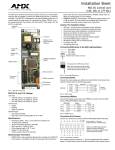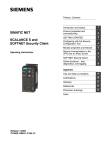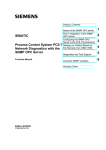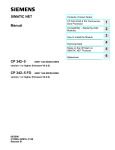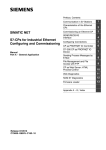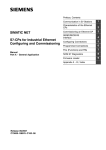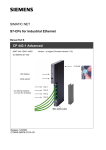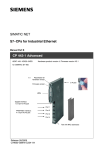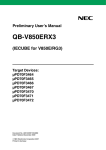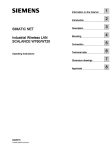Download User Manual
Transcript
Preface Area of Application and Characteristics 1 SIMATIC NET Functional Description of the SIM 1-2 2 ASIC SIM 1-2 Technical Specifications 3 Application Examples 4 Putting into Operation 5 Appendix A Function Manual Release 02/2007 C79000-G8976-C215-01 Classification of Safety-Related Notices This document contains notices which you should observe to ensure your own personal safety, as well as to protect the product and connected equipment. These notices are highlighted in the manual by a warning triangle and are marked as follows according to the level of danger: Danger indicates that death, severe personal injury will result if proper precautions are not taken. Warning indicates that death, severe personal injury can result if proper precautions are not taken. Caution with a warning triangle indicates that minor personal injury can result if proper precautions are not taken. Caution without a warning triangle indicates that damage to property can result if proper precautions are not taken. Notice indicates that an undesirable result or status can result if the relevant notice is ignored. Note highlights important information on the product, using the product, or part of the documentation that is of particular importance and that will be of benefit to the user. Trademarks SIMATIC®, SIMATIC NET®, SIMATIC NET Networking for Industry®, SINEC®, SCALANCE® and SINAUT® are registered trademarks of Siemens AG. Third parties using for their own purposes any other names in this document which refer to trademarks might infringe upon the rights of the trademark owners. Disclaimer We have checked the contents of this manual for agreement with the hardware and software described. Since deviations cannot be precluded entirely, we cannot guarantee full agreement. However, the data in this manual are reviewed regularly and any necessary corrections included in subsequent editions. Suggestions for improvement are welcome. Siemens AG Automation and Drives Industrial Communication Postfach 4848, D-90327 Nürnberg Copyright © Siemens AG, C79000-G8976-C215-01 Subject to technical change. Siemens Aktiengesellschaft Printed in the Federal Republic of Germany 2 Safety Instructions Regarding your Product Before you use the product described here, read the safety instructions below thoroughly. Qualified Personnel Only qualified personnel should be allowed to install and work on this equipment . Qualified persons are defined as persons who are authorized to commission, to ground, and to tag circuits, equipment, and systems in accordance with established safety practices and standards. Correct Usage of Hardware Products Note the following: Warning This device and its components may only be used for the applications described in the catalog or the technical description, and only in connection with devices or components from other manufacturers which have been approved or recommended by Siemens. This product can only function correctly and safely if it is transported, stored, set up, and installed correctly, and operated and maintained as recommended. Before you use the supplied sample programs or programs you have written yourself, make certain that no injury to persons nor damage to equipment can result in your plant or process. EU Directive: Do not start up until you have established that the machine on which you intend to run this component complies with the directive 98/37/EEC. Correct Usage of Software Products Note the following: Warning This software may only be used for the applications described in the catalog or the technical description, and only in connection with software products, devices or components from other manufacturers which have been approved or recommended by Siemens. Before you use the supplied sample programs or programs you have written yourself, make certain that no injury to persons nor damage to equipment can result in your plant or process. SIM 1-2 C79000-G8976-C215-01 3 Prior to Commissioning Prior to commissioning, note the following warning: Caution Prior to startup read the relevant documentation. For ordering data of the documentation, please refer to catalogs or contact your local Siemens representative. 4 SIM 1-2 C79000-G8976-C215-01 Preface Purpose of manual This manual supports you during the development of a Fieldbus Medium Attachment Unit (MAU) for 31.25 Kbps in compliance with IEC 61158-2 with the SIM 1-2 (Siemens IEC MAU) and a small number of external components. Which Data Link Layer protocol is implemented is irrelevant. In conjunction with a suitable communication controller, for example SPC 2-4, devices with a fieldbus attachment (supplied with power locally or over the bus) can be implemented with little effort. This manual serves both as a function manual and as a data sheet for the developer of the electronics. Aims With the aid of this manual, you will be able to develop a fieldbus medium attachment unit (MAU) for 31.25 Kbps for your application with little effort using the SIM 1-2. We assume that you are familiar with the relevant standards and specifications. Certification The products and systems listed in this document are manufactured and marketed using a quality management system complying with DIN ISO 9001 and certified by DQS (certificate register no. 2613). The DQS certificate is recognized in all IQNet countries (Reg. No.: 2613). SIM 1-2 C79000-G8976-C215-01 5 Preface 6 SIM 1-2 C79000-G8976-C215-01 Contents 1 2 3 4 Area of Application and Characteristics ...................................................................... 9 1.1 Overview.............................................................................................................. 9 1.2 Essential Characteristics ................................................................................... 11 Functional Description of the SIM 1-2 ........................................................................ 13 2.1 Block Diagram ................................................................................................... 13 2.2 2.2.1 2.2.2 Pin Description................................................................................................... 14 Pin Assignment.................................................................................................. 14 Pin Arrangement................................................................................................ 16 2.3 2.3.1 2.3.2 2.3.3 2.3.4 2.3.5 2.3.6 2.3.7 2.3.8 2.3.9 2.3.10 2.3.11 2.3.12 2.3.13 2.3.14 Basic Functions of the SIM 1-2.......................................................................... 17 Interfacing with the Bus Cable: VBUS and GND............................................... 17 Control Loop: CTR............................................................................................. 17 Current Sensing by SENSEP and SENSEM ..................................................... 17 Bus Connector ................................................................................................... 18 Receiver Input: RXIN ......................................................................................... 20 Impedance Converter Output/Input: VE/VESRD............................................... 20 Reference Circuit RIREF, RVCCVE, RVREG, RISOLL .................................... 20 Interface and Application Voltage VREG........................................................... 21 Internal Power Supply: VCCD/VCCA, VM......................................................... 21 Oscillator: XT0, XT1........................................................................................... 21 Digital Interface: TXE, TXS, RXA, RXS............................................................. 22 Test and Manufacturing Pins: TD, T0, T1, T2, TA............................................. 22 Mode Setting GIM and VCM.............................................................................. 22 Voltage Monitoring............................................................................................. 23 2.4 2.4.1 2.4.2 2.4.3 2.4.4 Power Supply of the Application........................................................................ 24 Power Supply VREG ......................................................................................... 24 Power Supply VE............................................................................................... 25 DC/DC Converters S1 and S2........................................................................... 26 Dimensioning the Backup Capacitor ................................................................. 27 2.5 2.5.1 2.5.2 2.5.3 2.5.4 2.5.5 2.5.6 2.5.7 Internal Functions .............................................................................................. 28 Impedance Converter ........................................................................................ 28 Shunt Regulator................................................................................................. 28 Signal Filter........................................................................................................ 28 Comparator, Carrier Detector ............................................................................ 29 Jabber Control ................................................................................................... 29 Wave Shaper ..................................................................................................... 29 Interface Logic ................................................................................................... 30 Technical Specifications.............................................................................................. 31 3.1 Limit Values ....................................................................................................... 32 3.2 Normal Operating Conditions and Characteristic Data ..................................... 35 3.3 Housing MLPQ 40 ............................................................................................. 41 Application Examples .................................................................................................. 45 4.1 4.1.1 Interface Logic ................................................................................................... 45 Overview of the Interface to the Communication Controller.............................. 45 SIM 1-2 C79000-G8976-C215-01 7 Contents 5 6 8 4.2 4.2.1 4.2.2 4.2.3 Power-saving Isolation with Optocouplers......................................................... 47 Internal Pulse Duration Modulator ..................................................................... 47 Internal Pulse Duration Demodulator ................................................................ 48 External Dynamic Signal Evaluation.................................................................. 51 4.3 Signal Assignment ............................................................................................. 52 4.4 4.4.1 4.4.2 4.4.3 4.4.4 Circuit Examples................................................................................................ 53 Block Diagram of the SIM 1-2 and SPC 4-2 with Galvanic Isolation................. 53 Diagram of the SIM 1-2 and SPC 4-2 without Galvanic Isolation...................... 54 External Components (recommended values) .................................................. 55 Notes on the Transistor ..................................................................................... 56 4.5 Layout Proposal................................................................................................. 57 Putting into Operation.................................................................................................. 59 5.1 Putting into Operation for the First Time............................................................ 59 5.2 Test Points......................................................................................................... 60 Appendix ....................................................................................................................... 61 6.1 References ........................................................................................................ 61 6.2 Addresses.......................................................................................................... 62 SIM 1-2 C79000-G8976-C215-01 Area of Application and Characteristics 1.1 1 Overview Examples of applications for the SIM 1-2 The SIM 1-2 (Siemens IEC MAU) allows the setting up of a fieldbus Medium Attachment Unit (MAU) for 31.25 Kbps complying with IEC 61158-2 regardless of the implemented data link layer protocol. In conjunction with a suitable communication controller, for example, SPC 4-2, devices with a fieldbus attachment can be implemented with little effort. The SIM 1-2 supports all send and receive functions (including jabber control) and the high-impedance decoupling of auxiliary energy from the bus cable. It provides a selectable, stabilized power supply and also allows the setup of an galvanically isolating power supply with a few passive components. As an alternative to the standard signal interface (TxS, TxE, RxS, RxA), the ASIC includes special interface logic that provides low power consumption and an easyto- implement interface for galvanic signal isolation. SIM 1-2 C79000-G8976-C215-01 9 Area of Application and Characteristics Block diagrams of examples The following diagram illustrates examples of SIM 1-2 applications. VBUS+ BusSpeisegerät Feldbus VBUSVBUS- VBUS+ Power Power 10 VBUS+ VBUS- VBUS- VBUS+ SIM 1-2 SIM 1-2 SIM 1-2 Slave Controller Slave Controller SPC 4 Application Controller Application Controller Application Controller Aktor Sensor Sensor SIM 1-2 C79000-G8976-C215-01 Area of Application and Characteristics 1.2 Essential Characteristics Description The essential characteristics of the SIM 1-2 (IEC MAU) are listed below. Characteristics of fieldbus attachment Using the SIM 1-2, a fieldbus attachment can be implemented with the following characteristics. ● The SIM 1-2 (IEC MAU) supports fieldbus attachments for 31.25 Kbps in compliance with IEC 6 1158-2. ● The SIM 1-2 can be connected to all Manchester encoders/decoders in compliance with IEC 61158-2. As a result, the SIM 1-2 can also be connected to all fieldbus controllers that already include a Manchester encoder/decoder in compliance with IEC 61158 2. ● Jabber inhibit (jabber control prevents a node from transmitting indefinitely on the bus) ● Sender with current modulator for bias currents: – Asymmetric modulation from 2 mA to 10 mA – Symmetric modulation from 10 to 50 mA Power-optimized electrical isolation The SIM 1-2 supports simple and power-minimized galvanic isolation between MAU and user electronics by means of: ● Integrated voltage converter for power-optimized, unregulated voltage transformation; external transformer and rectifier are required. ● Integrated interface logic for simple and current-saving galvanic signal isolation, current consumption in permanent operation < 2 mA; 2 optocouplers and suitable controller interface logic are necessary on the controller. SIM 1-2 C79000-G8976-C215-01 11 Area of Application and Characteristics Properties of the SIM 1-2 ● Minimum space required for the MAU interface ● Minimum number of external components ● Little space required due to SMD housing MLPQ 40 ● Ambient temperature range -40 to +85 °C ● Low current consumption for own supply ● Bus voltage 9 V to 32 V (functional range) ● Stabilized output voltage for the user: – Can be set in the range from 2 V to 5 V (tolerance ±3 %) – Up to 50 mA (total) available 12 ● On-chip voltage reference ● On-chip voltage monitoring ● On-chip RESET and PDWN for safe power-up and power down management of connected logic circuits SIM 1-2 C79000-G8976-C215-01 2 Functional Description of the SIM 1-2 2.1 Block Diagram Description The following block diagram represents the SIM 1-2 functions as blocks. RXA RXA1 Digitale Schnittstelle RXS RXS1 InterfaceLogik RXS2 Jabber Control TXE TXE1 TXS Mode RXA2 TXS1 Receiver Filter und Komparator Bandpass Tiefpass RxF 2. Ordnung 2.Ordnung Impedance Converter Current Modulator US UR DC/DC Control RSENSEP SENSEP SENSEM RSENSEM Current control S2 T1 CTR static current (2 .. 50mA) DC/DC BUS (9 .. 32V) TxM VCM S1 VBUS TXS2 GIM DC/DC CRXIN REx1 Waveshaper F = 31,25 kHz TXE2 RXIN RISOLL RIREF Referenz control CRISOLL RVCCVE CRVCCVE RRVCCVE RDCDC RRIREF RRISOLL VE / VESRD Clock Generator Power Management RESETXN RRDCDC PDWNXN GND SIM 1-2 C79000-G8976-C215-01 VCCD / VCCA CVCC VREG VCCRegulator 5V ShuntRegulator 6,3V VREGRegulator CVREG RVREG VM GND RRVREG CVE CRVREG CVM 13 Functional Description of the SIM 1-2 2.2 Pin Description 2.2.1 Pin Assignment Description The following table describes the assignment of the pin numbers to the symbolic pin names. The table also includes a brief description of the functions. I/O * 1) A/D * 2) Description 1 CTR O A Control output for controlling bus current over T1 2 SENSEP I/O A Actual current sensing for the bus current control and output of the startup bypass 3 SENSEM I/O A Correction of the actual current sensing for the bus current control by taking into account the circulating currents over Pad CTR and VBUS 4 RIREF I/O A Generation of an internal reference current with possible external adjustment 5 RISOLL I/O A Set reference for bus current control (2 mA to 50 mA corresponds to 0.1 MΩ to 2.5 MΩ) 6 RVCCVE I/O A Generation of an internal reference voltage and at the same time measuring point for an external adjustment to RIREF (target : U (RVCCVE) = 1 V) 7 RVREG I/O A Set reference for VREG (2 V to 5 V corresponds to 1.0 MΩ to 2.5 MΩ) 8 GND P A Ground 9 VE P A Regulated supply voltage (6.3 V), derived from U (RVCCVE); regulated only in conjunction with VESRD! 10 VESRD O A Collector of the control transistor of the shunt regulator 11 VREG P D Regulated supply voltage (2 V to 5 V), derived from VE and U (RVREG) 12 GND P D Ground 13 RxS O D Receive signal, output 14 RxA O D Receive activity, output 15 TxE I D Transmit enable, input No. Name Table continued on next page * 1) * 2) 14 I = input, O = output, P = power A = analog, D = digital SIM 1-2 C79000-G8976-C215-01 Functional Description of the SIM 1-2 Continued I/O * 1) A/D * 2) I D Transmit signal, input 17 RESETXN O D Reset output for external logic supplied by VREG 18 PDWNXN D Power down – Prewarning signal for external logic supplied by VREG No. Name 16 TxS O Description 19 TD Must be connected to GND. 20 T0 Must be connected to GND. 21 S2 O D Switch output 2 of DC/DC converter, open drain 22 GND P D Ground 23 S1 O D Switch output 1 of DC/DC converter, open drain 24 t1 Must be connected to GND. 25 T2 Must be connected to GND. 26 VCM I D Voltage converter mode – enabling of DC/DC converter 27 GIM I D Galvanic isolation mode – enabling of powersaving interface 28 GND P D Ground 29 PROG P D Must be connected to VCCD. 30 VCCD P D Regulated supply voltage (5 V) for digital circuit 31 XT1 I/O D Quartz or resonator connector, with external clock supply XT1 used as input 32 XT0 I/O D Quartz or resonator connector, with external clock supply XT0 is connected to GND 33 VCCA P A Regulated supply voltage (5 V) for analog circuit 34 GND P A Ground 35 TA Must be connected to GND. 36 VM O A Middle voltage reference (derived from VCCA) 37 RDCDC I A Reference for startup current of the DC/DC converter 38 RXIN I A Input of receiver filter 39 GND P A Ground 40 VBUS P A Connector for supplying the ASIC with the rectified bus voltage 41 GND P A/D Chassis, metal surface below the housing * 1) * 2) I = input, O = output, P = power A = analog, D = digital SIM 1-2 C79000-G8976-C215-01 15 Functional Description of the SIM 1-2 2.2.2 Pin Arrangement S2 20 21 VREG GND RxS RxA TxE TxS RESETXN PDWNXN TD T0 Pin layout in the 40-pin housing 40LD MLPQ 6x6 VJJD-2 11 10 VE GND S1 GND T1 RVREG T2 RVCCVE VCM RISOLL GIM RIREF SENSEM GND PROG SENSEP 41 31 1 CTR VBUS GND RXIN RDCDC VM TA GND VCCA 40 XT0 30 XT1 VCCD 16 VESRD SIM 1-2 C79000-G8976-C215-01 Functional Description of the SIM 1-2 2.3 Basic Functions of the SIM 1-2 The basic functions described in this section are required for the minimum functionality of the SIM 1-2. 2.3.1 Interfacing with the Bus Cable: VBUS and GND The interfacing to the positive side of the bus system is over VBUS. Externally, at least one diode must be included as polarity reversal protection to avoid both destruction of the ASIC and return feed to the bus cable if a short-circuit occurs. The interfacing to the negative side of the bus system is over GND. As an alternative to a diode as polarity reversal protection, a rectifier bridge can be used as polarity reversal protection and feedback protection. 2.3.2 Control Loop: CTR This output controls the base of the external PNP transistor T1 that supplies the local consumer connected to VE and switches to output signal to the bus by modulating the current consumption. 2.3.3 Current Sensing by SENSEP and SENSEM The shunt resistor RSENSEP is used to sense the current available as supply current over the collector. The current fed past RSENSEP over VBUS and CRT is sensed by the shunt resistor RSENSEM. The sum of the two currents corresponds to the current taken from the bus. SIM 1-2 C79000-G8976-C215-01 17 Functional Description of the SIM 1-2 2.3.4 Bus Connector Bus Current Consumption Using the resistor RRISOLL, the mean current taken from the bus is set from 2 mA to 50 mA. In the range from 2 mA to 10 mA, the SIM 1-2 automatically operates in the asymmetric modulation mode. This means that to transmit, the mean current consumption is raised to 10 mA and then lowered again to the set value. The set mean bus current must always be at least 1 mA higher than the current transferred to the application over VREG and VE (including DC/DC). RRISOLL [MΩ] = 0.05 * IBUS [mA] Conditions for RRISOLL: 100 KΩ ≤ RRISOLL ≤ 2.5 MΩ the capacitor CVE must be dimensioned in the permitted range according to the pulse load by the application or the DC/DC converter. Caution 1 To achieve the minimum bus current tolerance of 3 %, resistors with a tolerance of ≤ 0.1 % must be used. As an alternative, the bus current can be matched over RRISOLL (see also tolerance calculation in section 2.3.7, "Reference Circuit RIREF, RVCCVE, RVREG, RISOLL“). Caution 2 Transistor T1 and its cooling surface must be designed according to the set bus current consumption and the resulting dissipation loss. 18 SIM 1-2 C79000-G8976-C215-01 Functional Description of the SIM 1-2 Input Impedance To achieve the impedance of 3 kΩ required by IEC 61158-2 at the bus attachment terminals in conjunction with the transistor PZT3906, the EMC capacitances parallel to the bus connector must be limited as follows: 2 mA < IBUS ≤ 15 mA, CEMC ≤ 500 pF Starting at an IBUS current of 15 mA, the capacitance of CEMC must be reduced continuously. This results in a curve with the following vertices: IBUS CEMC 20 mA CEMC ≤ 340 pF 30 mA CEMC ≤ 190 pF 40 mA CEMC = 0 pF As of a current of ≥ 40 mA, CEMC remains = 0 pF. At IBUS currents > 40 mA, the required impedance (at 39 kHz) for bus voltages UBUS < 12 V is not achieved. System Stability We recommend the transistor PZT3906. If you set the IBUS current to ≥ 30 mA, you should use an additional L_SENSE inductor of 1 µH. This avoids self-excitation and increases system stability. The L_SENSE inductor is connected in series with R_SENSEP and is not included in the layout proposal in this manual. As the inductor, we recommend the B82422H from the EPCOS series. If necessary, correct the value of R_SENSEP to achieve the required 10 Ω with the desired accuracy. R_SENSEM SENSEM SENSEP SIM 1-2 C79000-G8976-C215-01 R_SENSEP L_SENSE 3 2 19 Functional Description of the SIM 1-2 2.3.5 Receiver Input: RXIN The received signal is coupled into the input filter over the external capacitor CRXIN (220 pF) and REX1 (10 kΩ). 2.3.6 Impedance Converter Output/Input: VE/VESRD These two connectors must be directly connected with each other and then over RSENSEP with the collector of the external transistor T1 and the external energy storage CVE. The voltage at VE/VESRD is regulated to a constant 6.3 V. 2.3.7 Reference Circuit RIREF, RVCCVE, RVREG, RISOLL Connect the contacts to the specified reference resistors. Contact Reference resistor Meaning RIREF RRIREF All internal references are derived from the current flowing through RRIREF. RVCCVE RRVCCVE RRVCCVE forms the reference for VCC and VE. The RVCCVE pin must be backed up to GND by capacitor CRVCCVE. RVREG RRVREG RRVREG forms the reference for VREG. The RVREG pin must be backed up to GND by capacitor CVREG. RISOLL RRISOLL RRISOLL sets the middle current taken from the bus system. Notice: The tolerance of reference resistors is included in the tolerance of the bus current. You can achieve the minimum tolerance of 3 % with resistors that have a tolerance of ≤ 0.1 %. As an alternative, the bus current can be adjusted over RRISOLL. 20 SIM 1-2 C79000-G8976-C215-01 Functional Description of the SIM 1-2 Tolerance Calculation The tolerance of IBUS, VE and VREG is made up the tolerance of the chip and the tolerance of the reference resistors used RRIREF, RRVCCVE, RRVREG, RRISOLL, RSENSEM and RSENSEP. The precise relationships can be seen in the following formulas. dIBUS = |dSIM 1-2| + |dRRISOLL| + |dRRIREF| + (β(T1) / (β(T1) + 1)) * |dRSENSEP| + (1 / (β(T1) + 1)) * |dRSENSEM| dVE = |dSIM 1-2| + |dRRVCCVE| + |dRRIREF| dVREG = |dSIM 1-2| + |dRRVREG| + |dRRIREF| The tolerance of the parameters of IBUS, VE and VREG over the entire temperature range (assuming a circuit with almost ideal reference resistors) is ±3 %; it therefore follows that: dSIM 1-2 = ±3 %. 2.3.8 Interface and Application Voltage VREG With VREG, there is an operating voltage regulated by RRVREG in the range from 2 V to 5 V for local loads. This is also the power supply for the outputs and inputs of the digital interface (TXE, TXS, RXA, RXS, RESETXN, PDWNXN). 2.3.9 Internal Power Supply: VCCD/VCCA, VM The two pins VCCD and VCCA must be connected directly with each other and backed up to GND over the capacitor CVCC. No power for local loads may be taken from the internal power supply VCC. The VM pin must be backed up to GND by capacitor CVM. 2.3.10 Oscillator: XT0, XT1 Pins XT0 and XT1 are provided for the connection of a 2 MHz quartz/ceramic oscillator. Further external components (capacitances) are required depending on the quartz/ceramic oscillator used. With external clock supply, XT0 is connected to GND and XT1 is used as an input. XT0 and XT1 may each be loaded with a capacitance of ≤ 47 pF. SIM 1-2 C79000-G8976-C215-01 21 Functional Description of the SIM 1-2 2.3.11 Digital Interface: TXE, TXS, RXA, RXS Possible interconnection between the external interface circuit, for example SPC 4-2, and the SIM 1-2: ● Direct connection of TXE, TXS, RXA, RXS with the digital input and output drivers of an external communication controller for the external application electronics. ● Connection of TXE, TXS, RXA, RXS with the digital input and output drivers of an external communication controller galvanically isolated over optocouplers for the external application electronics. ● Interfacing using the power-saving galvanic signal isolation over two optocouplers TXS and RXS. 2.3.12 Test and Manufacturing Pins: TD, T0, T1, T2, TA For the SIM 1-2 to function perfectly, the test and manufacturing pins TD, T0, T1, T2, and TA must be connected to GND. 2.3.13 Mode Setting GIM and VCM Galvanic Isolation Mode (GIM) This input is used to activate or deactivate the power-saving interface to the application. GIM 22 Meaning High The power-saving pulse duration modulation is used both for the inputs (demodulator on TXS) and for the output (modulator on RXS). Low The power-saving pulse duration modulation is not active. SIM 1-2 C79000-G8976-C215-01 Functional Description of the SIM 1-2 Voltage Converter Mode (VCM) This input is used to activate or deactivate the DC/DC converter controller. VCM Meaning High The DC/DC converter is active and controls the outputs S1, S2. Low The DC/DC converter is disabled, the outputs S1, S2 are switched with high impedance. 2.3.14 Voltage Monitoring Voltage Monitor The voltage monitor monitors the internally generated voltages VE, VCC and VREG. RESETXN pin At the RESETXN pin, the SIM 1-2 signals the end of the startup phase with a change from low to high. This means that all required power supplies have reached their desired value. If the VREG voltage sinks below 90 % of the desired value VREGSOLL, a change from high to low at the RESETXN pin signals the reset status of the chip. PDWNXN pin At the PDWNXN pin, the SIM 1-2 signals an interruption of the bus supply with a short low pulse. Controlled by this signal, the connected application can initiate a power down sequence. If the VE voltage sinks below 90 % of the desired value VESOLL, the prewarning PDWNXN (PDWNXN changes to logic '0' for 10 µs) is output. Communication over TxE, TxS, RxA and RxS is not affected by this. SIM 1-2 C79000-G8976-C215-01 23 Functional Description of the SIM 1-2 2.4 Power Supply of the Application For the power supply of the external application electronics, it is only ever possible to take as much energy as is taken on average from the bus system less the power consumption of the SIM 1-2 itself. 2.4.1 Power Supply VREG The VREG voltage that can be set between 2 V and 5 V regulated by RRVREG is available as a non-floating power supply for the external application electronics. The VREG power supply can be subjected to a maximum load of 50 mA. RRVREG [MΩ] = 0.5 * VREG [V] Conditions for RVREG: 1 MΩ <= RVREG ≤ 2.5 MΩ Notice: You achieve the minimum VREG tolerance of 3 % if you use a resistor with a tolerance of ≤ 0,1 % for RRVREG (see also the tolerance calculation in section 2.3.7, "Reference Circuit RIREF, RVCCVE, RVREG, RISOLL“). 24 SIM 1-2 C79000-G8976-C215-01 Functional Description of the SIM 1-2 2.4.2 Power Supply VE Caution The VE voltage of 6.3 V generated by the shunt regulator cannot be used immediately after turning on the power supply of the external application electronics since this can disrupt the startup of the SIM 1-2 considerably. On completion of the startup phase (indicated by RESETXN), the VE voltage can be used to supply the external application electronics. It is, however, important to make sure that the VE never falls below 80% as a result of sudden load changes. If the VE voltage sinks below 90% of VESOLL, a prewarning PDWNXN (low-active) is output (PDWNXN changes to logic '0' for 10 µs). Communication over TxE, TxS, RxA and RxS is not affected by this. If the VE voltage falls below 80% of VESOLL, the DC/DC converter and the VREG regulator are turned off. They start again only when VE has reached 92 % again. When using CVE backup capacitors higher than 33 µF, it is advisable to connect a 1 Ω resistor in series with the capacitor CVE to minimize the risk of superimposing oscillations on the VE power supply. SIM 1-2 C79000-G8976-C215-01 25 Functional Description of the SIM 1-2 2.4.3 DC/DC Converters S1 and S2 These outputs are switches for setting up a DC/DC converter. By connecting a transformer, a push-pull transformer for the power supply of a non-floating load can be implemented. Two stages of the DC/DC converter start up as soon as a stable VE supply voltage is present: in other words, before RESET becomes inactive. To ensure that the VE supply voltage does not break down when the push-pull transformer is starting up (depending on the backup capacitance CVE and the set bus current), the startup takes several stages. The result of startup depends largely on the load on the secondary side. It switches to normal operation after 20 ms with the bridge branches then only functioning as switches. If the voltage at VE sinks below 80% of its desired value due to the load, the startup is repeated from the beginning. The voltage at the open circuit breaker achieves twice the voltage of VE due to center tapped transformer connected downstream. Moreover, the energy stored in the leakage inductance of the transformer can induce brief voltage peaks when switching the transistor bridge (circuit breaker) that are far higher than twice the value of VE and therefore destroy the circuit breaker. To prevent this, the voltage is limited internally to approximately 20 V. The ability of this voltage limitation to absorb is, however, limited to the energy stored in a leakage inductance of 15 µH. When using a transformer with a leakage inductance of 15 µH to 70 µH, an additional protective circuit must be use to limit the voltage to 2xVE < US1,S2 << 20 V. A protective circuit between VE and the circuit breakers S1 and S2, each consisting of BAT45 and BZX84C7V5 connected in series. ● Transformers with a leakage inductance up to 15 µH can be activated at S1 and S2 without any further protective circuit. ● Transformers with a leakage inductance up to 70 µH can only be activated at S1 and S2 with additional protective circuits (see section 4.4, „Circuit Examples“). ● Transformers with a leakage inductance > 70 µH cannot be used. The effective capacitive load on the secondary side during startup (CDCDC) should not exceed 22 µF at IBUS = 50 mA and 4.7 µF at IBUS = 8 mA (see section 2.4.4, "“). When using the DC/DC converter on S1 and S2. a minimum current IBUS ≥ 8 mA is recommended. 26 SIM 1-2 C79000-G8976-C215-01 Functional Description of the SIM 1-2 2.4.4 Dimensioning the Backup Capacitor To allow a correct startup behavior, the set constant current consumption and the backup capacitors CVE and CDCDC must be matched up. Secondary capacitor CDCDC The dimensions of the secondary capacitor of transformer CDCDC must not be too large depending on the constant current: CDCDC < IBUS * 0.5 µF/mA Capacitor CVE The following applies to capacitor CVE: CVE > 2 * Ü * CDCDC where Ü = VDCDC/VE Capacitor CVREG The following applies for capacitor CVREG: CVREG ≤ 47 µF SIM 1-2 C79000-G8976-C215-01 27 Functional Description of the SIM 1-2 2.5 Internal Functions 2.5.1 Impedance Converter The impedance converter/current modulator and current control function units together along with a few external components and the internal shunt regulator form the high-impedance decoupling of the auxiliary power from the bus cable. 2.5.2 Shunt Regulator The shunt regulator derives a stabilized voltage VE from the constant current. The part of the total current not required by external loads is diverted to GND. The load current can be taken in any proportions from the power supplies VREG and the DC/DC converter (external transformer necessary). 2.5.3 Signal Filter The combined input high pass, band pass and low pass filter suppresses disturbances outside of the signal transmission range from 7 kHz to 40 kHz. The band pass and low pass filter is implemented as a switched capacity filter. The input high pass filter is made up of REX1 and CRXIN . 28 SIM 1-2 C79000-G8976-C215-01 Functional Description of the SIM 1-2 2.5.4 Comparator, Carrier Detector From the filtered received signal RxF, the comparator forms a logic signal RxS2 suitable for further processing. A carrier detector also monitors the received signal and generates the carrier detect signal RxA2 dependent on the signal amplitude. 2.5.5 Jabber Control If a node is malfunctioning so that it constantly tries to transmit data via the bus connection ( MAU ), the data flow must be interrupted to avoid the malfunctioning node for blocking the transmission medium (jabber inhibit). The SIM 1-2 meets the standard IEC 61158-2. It specifies that transmission of a message to the medium will be interrupted if the message duration exceeds a time of 120 to 240 ms. At the same time, the transmission of the RxS1 data and the RxA1 signal to the node must be inhibited. After a time of 3 s ± 50% the inhibit is canceled and monitoring the duration of an existing message is restarted. If the malfunction on the node persists, cancellation of the inhibit be repeated periodically every 3 s ± 50%. Monitoring cannot be disabled. 2.5.6 Wave Shaper From the logic signals TxS2 and TxE2, the wave shaper generates the analog signal TxM with which the IBUS current is modulated. SIM 1-2 C79000-G8976-C215-01 29 Functional Description of the SIM 1-2 2.5.7 Interface Logic The interface logic forms the interface to the communication controller of the user electronics. Three operating modes are possible: Without galvanic isolation If galvanic isolation of the bus interface (MAU) from the application-specific electronics is not required, the send or received signals with GIM = L on the interface are passed on without any processing and switched through to the user electronics. The output level of RxA and RxS is adapted over the interface and application voltage VREG. Conventional isolation with optocouplers To achieve galvanic isolation of the lines for data and associated signals, various isolating components and circuits can be used. One common method is to provide an optocoupler for each of the signals TxS, TxE, RxS and RxA. Power-saving isolation with optocouplers The SIM 1-2 also provides the option of a power-saving galvanic isolation with only 2 optocouplers. 30 SIM 1-2 C79000-G8976-C215-01 Technical Specifications 3 This section contains the technical specifications of the SIM 1-2. SIM 1-2 C79000-G8976-C215-01 31 Technical Specifications 3.1 Limit Values Description The following table lists the limit values of the SIM 1-2 that must not be exceeded! Caution These maximum operating conditions must not be exceeded under any circumstances, otherwise the SIM 1-2 may be destroyed. All voltages relate to GND. A current flowing out of a pin is preceded by a negative sign. Values for bus interfacing Name/pin Parameters Min Max Unit VBUS Supply voltage -0.3 35.0 V SENSEP, SENSEM, CTR, RXIN Voltage at the inputs and outputs -0.3 VBUS +0.3 V I (CTR) Control current at base of T1 -5 5 mA Min Max Unit -0.3 7.0 V 60 mA VE +0.3 V Remark RXIN over REX1 and CTR Values for supply VE Name/pin Parameters VE Supply voltage I (VE) Load current RIREF, RVCCVE, RVREG, RISOLL Voltage at the inputs and outputs 32 -0.3 Remark SIM 1-2 C79000-G8976-C215-01 Technical Specifications Values for supply VCC Name/pin Parameters VCCA, VCCD Supply voltage I (VCCA) + I (VCCD) Load current VM, TEST1, Voltage at the inputs and TEST2, RDCDC, outputs GIM, VCM, XT0, XT1 Min Max Unit -0.3 7.0 V -2 50 mA -0.3 VCCA +0.3 or VCCD +0.3 V Min Max Unit Remark Maximum is peak value if a short occurs (flows over VCCA) Values for supply VREG Name/pin Parameters Remark VREG Supply voltage -0.3 7.0 V I (VREG) Load current -55 300 mA TxE, TxS, RxA, RxS, PDWMXN, RESETXN Voltage at the inputs and outputs -0.3 VREG +0.3 V I (RxA), I (RxS) Load current -2 16 mA IOH, IOL I (PDWMXN), I (RESETXN) Load current -1 5 mA IOH, IOL Min Max Unit Remark -0.3 20.0 V Internal terminal voltage (with current limitation!) 40 mA The maximum is the peak value if a short circuit occurs. Values for DC/DC activation Name/pin Parameters S1, S2 Voltage at the outputs I (S1), I (S2) Load current considered as mean SIM 1-2 C79000-G8976-C215-01 33 Technical Specifications Values for environmental influences and processing Name/pin Parameters Min Max Unit TOP Ambient temperature -40 85 °C TSTG Storage temperature -55 150 °C TJ Junction operating temperature 135 (preliminary) °C Rth j-a Heat transfer resistance junction/environment Housing Solder profile Housing Solder temperature Housing Moisture sensitivity level l All pins Lead finish All pins ESD resistance 34 26 K/W Pb free 260 °C Thermal resistance from junction to ambient in free air JEDEC J-STD-020C JEDEC J-STD-020C Sn +1 Operating junction Temperature JEDEC J-STD-020C MSL 3 -1 Remark Pb free kV Human body model SIM 1-2 C79000-G8976-C215-01 Technical Specifications 3.2 Normal Operating Conditions and Characteristic Data Note The following tables list the normal operating conditions and characteristic data of the SIM 1-2 and are structured according to the corresponding power supply. The information covers the spread of values that must be kept to at a bus voltage VBUS of 9 V to 32 V and an ambient temperature of –40 °C to 85 °C. All voltages relate to GND. A current flowing out of a pin is preceded by a negative sign. SIM 1-2 C79000-G8976-C215-01 35 Technical Specifications Values for bus interfacing Name/pin Parameters Min VBUS Bus voltage IBUS Static minimum bus current 1,94 IBUS Static maximum bus current IMPP Modulation current I (VBUS) Input current at VBUS pin IVBUSBYPASS Typ. 9.0 Max Unit Remark Not applied directly to SIM 1-2. 32.0 V 2 2,06 mA Tolerance +/-3 % 48,5 50 51,5 mA Tolerance +/-3 % 16.0 17.5 19.0 mA Peak-to-peak value 0.4 0.55 0.75 mA Bypass current Own current requirements startup bypass 40 µA Own power requirements VBUS SENSEP, SENSEM Voltage at SENSEP and SENSEM 7.5 V I (SENSEP) Current SENSEP pin -0.75 I (SENSEM) Current SENSEM pin 0.6 mA Bypass current mA Compensation current RSENSEP, RSENSEM Actual current value detection CTR Control voltage at base of T1 0 32 V I (CTR) Control current at base of T1 0 0.5 mA RXIN Voltage at RXIN 0 32 V RI (RXIN) Input resistance of the input stage 100k 36 10 Ω Ω 0.1 % tolerance and TK < 15 ppm/K, to achieve 3 % tolerance of the circuit Minimum input resistance of the receiver stage SIM 1-2 C79000-G8976-C215-01 Technical Specifications Values for supply VE Name/pin Parameters VE, VESRD Voltage at shunt regulator PDWNXN Prewarning threshold for PDWNXN Min Typ. 6,111 RESETXN Reset threshold for RESETXN I (VE) Max 6,3 Unit 6,489 V 0.9 * VESOLL V 0.9 * VREGSOLL V Own current requirements entire SIM 1-2 I (VESRD) Load current at shunt regulator 4.7 -10 % Remark Tolerance +/-3 % 860 µA DC/DC function deactivated. 52.5 mA Considered as mean 100 +10 % µF Tantalum *1) TAJA475K016R, TAJC107K010R CVE Capacitance at VE RRIREF Reference current generation 1.5 MΩ *2) RRVCCVE Reference voltage generation for VCC and VE 1.0 MΩ *2) RRVREG Reference voltage generation for minimum value VREG = 2 V 1.0 MΩ *2) RRVREG Reference voltage generation for maximum value VREG = 5 V 2.5 MΩ *2) RRISOLL Bus current setting for minimum value IBUS = 2 mA 100 kΩ *2) RRISOLL Bus current setting for maximum value IBUS = 50 mA 2.5 MΩ *2) CRVCCVE Capacitance 9 10 11 nF Ceramic 6.3 V CRVREG Capacitance 42.3 47 51.7 nF Ceramic 6.3 V CRISOLL Capacitance 29.7 33 36.3 nF Ceramic 6.3 V *1) At CVE > 33 µF, it is recommended that a 1 Ω resistor is connected in series with CVE. *2) 0.1 % tolerance and TK < 15 ppm/K, to achieve 3 % tolerance of the circuit. SIM 1-2 C79000-G8976-C215-01 37 Technical Specifications Name/pin Parameters Min VCCA, VCCD Supply voltage VCC 4.75 CVCC Capacitance at VCC pin 0.9 VM Middle voltage CVM Capacitance at VM pin XT0. XT1 Typ. Max 5.0 Unit Remark 5.25 V Only used internally. 3,63 µF Tantalum TAJA105K016R, TAJA335K016R 0.5 * VCCA V 90 100 110 nF Clock generation 2 MHz 1.99 2.0 2.01 MHz XT0. XT1 Voltage at XT0 and XT1 -0.3 VCCA +0.3 V CXT0, CXT1 Load capacitance 10 47 pF VCM, GIM Input signal high 4.0 VCM, GIM Input signal low VCM, GIM Input signal hysteresis VCM, GIM Input current Ceramic 6.3 V Tolerance +/0.5 % (plus the vendorspecific initial tolerance for the typical value) V 1.0 0.5 V V +10 µA VIN = GND to VCCD Values for supply VREG Name/pin Parameters Min Typ. Max Unit Remark VREG Desired voltage at VREG = 2 V 1,94 2 2,06 V Tolerance +/-3 % VREG Desired voltage at VREG = 5 V 4,85 5 5,15 V Tolerance +/-3 % I (VREG) Load current CVREG Capacitance at VREG pin 38 0 50 mA 4.7 -10 % 22 +10 % µF Tantalum TAJA475K016R, TAJA226K016R SIM 1-2 C79000-G8976-C215-01 Technical Specifications Values for DC/DC activation Name/pin S1, S2 Parameters Terminal voltage S1 and S2 (see section 2.4.3) Min Typ. Max 2 * VE I (S1), I (S2) Load current considered as mean RDSON RDSON of switches S1 and S2 1.5 Unit Remark V Internally or externally limited 40 mA 8 Ω Per switch Values for Communication Interface Name/pin Parameters RESETXN, PDWNXN Output signal VOH RESETXN, PDWNXN Output signal VOL RxA, RxS Output signal VOH RxA, RxS Output signal VOH RxA, RxS Output signal VOL RxA, RxS Output signal VOL TxE, TxS Input signal VH TxE, TxS Input signal VL TxE, TxS Input signal VHYST TxE, TxS Input current SIM 1-2 C79000-G8976-C215-01 Min Typ. Max Unit Remark V IOH = -1 mA V IOL = 5 mA VREG -0.1 V IOH = -0.1 mA VREG -0.5 V IOH = -0.8 mA 0.1 V IOL = 0.1 mA 0.4 V ● If IOL = 10 mA and VREG 3 V to 5 V ● If IOL = 4 mA and VREG 2 V to 3 V V GIM = GND 0.35 * VREG V GIM = GND 0.3 * VREG V +10 µA 0.8 * VREG 0.4 0.65 * VREG 0.1 VIN = GND to VREG 39 Technical Specifications Values for environmental influences Name/pin TOP 40 Parameters Ambient temperature Min Typ. -40 Max Unit 85 °C Remark In operation SIM 1-2 C79000-G8976-C215-01 Technical Specifications 3.3 Housing MLPQ 40 Drawing of the Housing SIM 1-2 C79000-G8976-C215-01 41 Technical Specifications Housing Dimensions The following table lists the dimensions of the housing in millimeters. Meaning Min. Max. A 0.8 0.9 1.0 A1 0 0.02 0.05 A3 0.2 D 6.0 D2 4.0 I E2 L 4.15 4.25 6.0 4.0 e 42 Typical 4.15 4.25 0.5 0.3 L1 0.03 b 0.18 0.4 0.5 0.25 0.30 0.15 SIM 1-2 C79000-G8976-C215-01 Technical Specifications Manufacturing Notes Caution 1 The ESD protection measures must always be adhered to for all electronic components. Caution 2 The SIM 1-2 is a component at risk of cracking that must be handled as such. • Before processing the SIM 1-2, it must be subjected to a drying process if the chip has been stored for more than 168 hours without being dry packed (according to JEDEC J-STD-020C Moisture Sensitivity Level 3). • The component must then by dried at 125 °C for 24 hours and processed within 48 hours. This drying may only be performed once due to the solderability of the component (according to JEDEC J-STD-020C Moisture Sensitivity Level 3). • The SIM 1-2 is approved for infrared reflow with the lead-free reflow profile according to JEDEC JSTD-020C. • The lead-free infrared reflow process must not exceed a maximum temperature of 260 °C on the surface of the package and may be 260 °C for only three seconds. Over a period of maximum 150 seconds, the temperature of the package surface may exceed 217 °C (according JEDEC J-STD-020C). • Lead finish: Sn SIM 1-2 C79000-G8976-C215-01 43 Technical Specifications 44 SIM 1-2 C79000-G8976-C215-01 Application Examples 4.1 Interface Logic 4.1.1 Overview of the Interface to the Communication Controller 4 The interface logic forms the interface to the communication controller of the user electronics. As shown in the following diagram, three modes are possible. ● Without galvanic isolation If galvanic isolation of the bus interface (SIM1-2) from the application-specific electronics is not required, the send or received signals are passed on without any processing and switched through to the user electronics. (Figure a). The output level of RxA and RxS is adapted over the output voltage VREG as reference voltage. ● Conventional isolation with optocouplers To achieve galvanic isolation of the lines for data and associated signals, various isolating components and circuits can be used. The conventional method is a separate optocoupler each for the signals TxS, TxE, RxS and RxA (Figure b). ● Power-saving isolation With the power-saving galvanic isolation, only two optocouplers are necessary, the data is then transferred using pulse duration modulated signals in the galvanic isolation mode (Figure c). The Galvanic Isolation Mode (GIM) is enabled with GIM = H. The send and receive functions are implemented separately so that if the physical characteristics of the bus are correct, the frame sent over TXS can be received over RXS. The following two sections explain this circuit in more detail. SIM 1-2 C79000-G8976-C215-01 45 Application Examples 46 SIM 1-2 C79000-G8976-C215-01 Application Examples 4.2 Power-saving Isolation with Optocouplers 4.2.1 Internal Pulse Duration Modulator Description of the Signal Shaping in the Modulator In Galvanic Isolation Mode (GIM = H), the PD modulator converts the serial signal to be transferred into a duration modulated pulse train in which the rising edge of the send signal is assigned a long pulse and the falling edge a short pulse. A long and a short pulse are also generated with the edges of the static associated signal and added to the pulse train of the data signal. The total signal generated in this way is used to drive the LED of an optocoupler. Design Example SIM 1-2 C79000-G8976-C215-01 47 Application Examples 4.2.2 Internal Pulse Duration Demodulator Description of the Input Evaluation In Galvanic Isolation Mode (GIM=H) the wanted signal for the PD demodulator is obtained from the collector signal of the optocoupler transistor using a comparator. The signal transitions (especially during operation with low currents) behave differently over time depending on the characteristics of the optocoupler itself and its circuitry. Evaluation with a fixed discriminator threshold on the comparator leads to different delays of the edges causing unacceptable signal distortions. It is possible to minimize the distortion if the when the switching times of the comparator are close to the beginning of the signal changes. This, however, requires different switching thresholds dependent on the edge or signal directions. A suitable adaptation of the switching threshold can be implemented if this is derived from the wanted signal itself. The principle behind this dynamic input signal evaluation is shown in the figure below. At the same time, the reference signal of a comparator is obtained from the wanted signal over a damping element a and a delay element. Circuit Principle of Input Evaluation ➀ ➁ 48 SIM 1-2 C79000-G8976-C215-01 Application Examples Description of the Signal Evaluation The leading edge on an incoming pulse ➁ triggers a time stage with a run time of t3. The following time condition applies: t1 < t3 < t2. On expiry of t3, a scan for pulse length t1 or t2 is performed. Depending on the detected pulse length t1 or t2, the flip-flop FF 1 is set to L or H. The output of the flip-flop therefore corresponds to the serial data signal ➃. The output signal ➄ of a further flip-flop FF 2 is ORed with signal ➃. If two short pulses occur one after the other, both flip-flops are reset. The OR operation results in an L, which is detected as the end of the static signal ➅. A further triggerable delay element t4 (40 *s * t4 * 100 µ*s) resets both evaluation flip-flops with the signal ➆ in transmission pauses to suppress undefined signals being set as a result of noise. Pulses < 0.5 *s at the comparator output will be suppressed reliably, pulses * 1 µs will be reliably detected. Principle of Demodulator Signal Evaluation SIM 1-2 C79000-G8976-C215-01 49 Application Examples Signal Evaluation in the Demodulator 50 SIM 1-2 C79000-G8976-C215-01 Application Examples 4.2.3 External Dynamic Signal Evaluation Description of the Dynamic Input Evaluation The circuit below is an example of retrieving the useful signal from the collector signal of the optocoupler transistor for the downstream communication controller in galvanic isolation mode. The two voltage dividers R2/R3 and R4/R5 move the working range of the comparator to the middle of the SPC-4–2 supply voltage VCC. The difference between the values of R2 and R4 results in an offset in the quiescent state. R6 brings about a reduction in amplitude and C2 a delay of the reference voltage in the active state. The capacitor C1 decouples the supply voltage of the optocoupler from the communication controller supply voltage VCC. Example of Demodulator Input Evaluation VCC 5V R1 R2 5,6k 22k C1 1n R4 27k R6 TxSD 5,6k Referenzspannung 2 + Komp.1 3 - 1 R3 68k 1 2 Ausgang Optokoppler nach Koppelkondenstor C R5 68k C2 68pf 3 Ausgang Komparator GND SIM 1-2 C79000-G8976-C215-01 51 Application Examples 4.3 Signal Assignment Description On the SIM 1-2, the signals are assigned in compliance with the IEC 61158-2 standard. The figure below describes the assignment of the logical state of TxS to the signal adjustment VBus+—VBus- (or the assignment of VBus+—VBus- to RxS). Signal Assignment 52 SIM 1-2 C79000-G8976-C215-01 Application Examples 4.4 Circuit Examples 4.4.1 Block Diagram of the SIM 1-2 and SPC 4-2 with Galvanic Isolation SIM 1-2 C79000-G8976-C215-01 53 Application Examples 4.4.2 54 Diagram of the SIM 1-2 and SPC 4-2 without Galvanic Isolation SIM 1-2 C79000-G8976-C215-01 Application Examples 4.4.3 External Components (recommended values) If you want to achieve the described accuracy of the SIM 1-2, the SIM 1-2 must be connected to the external components listed in the following table. Name Meaning RSENSEM, Actual current value RSENSEP detection RRIREF Reference current generation RRISOLL Bus current setting RRVCCVE Reference voltage VCC, VE RVREG Reference voltage VREG REX1 Input high pass RRDCDC CVE DC/DC startup current limitation Backup capacitance CVREG Backup capacitance CVCC Backup capacitance CVM CRXIN CRISOLL CRVCCVE CRVREG CDCDC D1-D4 D5, D6 D7, D8 D9, D10 t1 Q1 Transfor mer Backup capacitance Input high pass Backup capacitance Backup capacitance Backup capacitance Backup capacitance Transistor Murata CSTCC_G_A Transformer Type Rated value Unit Tolera nce Temp. coeff. Metal layer 10 Ω ±0.1 % 15 ppm/K Metal layer 1.5 MΩ ±0.1 % 15 ppm/K Metal layer Metal layer - 0.1 to 2.5 1.0 MΩ ±0.1 % MΩ ±0.1 % 15 ppm/K 15 ppm/K Metal layer 1.0 to 2.5 MΩ ±0.1 % 15 ppm/K Tantalum TAJA475K016R, TAJC107K010R Tantalum TAJA475K016R, TAJA226K016R Tantalum TAJA105K016R, TAJA335K016R Ceramic Ceramic Ceramic Ceramic Ceramic Tantalum Schottky Schottky Z-diode Schottky PNP 10 kΩ ±1 % 56 kΩ ±0.1 % Voltag e 100 ppm/K 15 ppm/K 4.7 to 100 *) µF ±10 % 10 V 4.7 to 22 µF ±10 % 10 V 1.0 to 3.3 µF ±10 % 10 V 100 220 33 10 47 ≤ 22 BAT86 BAT65 BZX84C7 V5 BAT65 PZT3906 2 nF pF nF nF nF µF ±5 % ±5 % ±5 % ±5 % ±5 % ±10 % MHz *) At CVE > 33 µF, it is recommended that a 1 Ω resistor is connected in series with CVE SIM 1-2 C79000-G8976-C215-01 55 Application Examples 4.4.4 Notes on the Transistor As an alternative to the recommended transistor PZT3906, the transistor PZT2907A can be used for IBUS currents ≥ 10 mA. However to increase system stability (avoiding self excitation) an inductor (3.3 µH) must be included in series in addition to the RSENSEP measuring resistor (see section 2.3.3, "Current Sensing by SENSEP and SENSEM“). Please not the following restrictions regarding EMC capacitance for the transistor PZT2907A: 10 mA ≤ IBUS ≤ 50 mA, CEMC ≤ 500 pF With the transistor PZT2907A and an EMC capacitance CEMC ≤ 500 pF, the required impedance is achieved (at 39 kHz) for bus voltages UBUS ≥ 9 V and 10 mA ≤ IBUS ≤ 50 mA. 56 SIM 1-2 C79000-G8976-C215-01 Application Examples 4.5 Layout Proposal To ensure optimum functionality of the SIM 1-2, certain layout rules should be adhered to. ● Connection from pin CRT to base of T1 as short as possible ● Connection from SENSEP over RSENSEP to capacitor CVE and connection from SENSEM over RSENSEM to capacitor CVE as short as possible and symmetrical ● When using a transformer as DC/DC converter, this should be wired as short as possible to the switches S1 and S2 and the power supply VE. SIM 1-2 C79000-G8976-C215-01 57 Application Examples 58 SIM 1-2 C79000-G8976-C215-01 Putting into Operation 5.1 5 Putting into Operation for the First Time Description Before putting into operation for the first time, check the correct wiring and components according to the block diagrams. In particular, check the reference resistances RRIREF, RRISOLL, RRVCCVE and RRVREG and the connection VE/VESRD and the connection VCCA/VCCD. Caution An interruption at the reference resistances RRIREF and RRISOLL during operation can lead to damage/destruction of the SIM 1-2. SIM 1-2 C79000-G8976-C215-01 59 Putting into Operation 5.2 Test Points Description To check the functionality, the following measurements can be made during operation. Measured value Description VE Voltage at pin VE/VESRD = 6.3 V VCC Voltage at pin VCCA/VCCD = 5.0 V VREG Voltage at VREG pin according to RRVREG tolerance IBUS Total current consumption according to RRISOLL tolerance Check whether or not the voltages and the current are within the tolerance range resulting from the tolerance of the selected resistors from the tolerance calculation in section 2.3.7. 60 SIM 1-2 C79000-G8976-C215-01 A Appendix 6.1 References /1/ IEC 61158-2 Digital data communications for measurement and control – Fieldbus for use in industrial control systems, Part 2: Physical layer specification and service definition /2/ PROFIBUS Test Guidelines for Field Devices according to "PROFIBUS-PA Profile for Process Control Devices, Version 3.0“, Version 3.1, April 2000, Order number 2.061 /3/ FOUNDATION™ Specification 31.25 Kbps Physical Layer Conformance Test SIM 1-2 C79000-G8976-C215-01 61 Appendix 6.2 Addresses PROFIBUS User Organization PNO Geschäftsstelle Hr. Dr. Wenzel Haid- und Neu- Straße 7 76131 Karlsruhe, Germany Tel.: +49 721 9658 590 Technical Information in Germany and Europe Siemens AG A&D SE RD73 Postfach 2355 90713 Fürth, Germany Tel.: Fax: E-mail: +49 911 750 2080 +49 911 750 2100 [email protected] Technical Information Outside Europe PROFIBUS Interface Center One Internet Plaza PO Box 4991 Johnson City, TN 37602 4991 Fax: BBS: E-mail: +01 423 262 2103 +01 423 262 2576 [email protected] 62 SIM 1-2 C79000-G8976-C215-01






























































